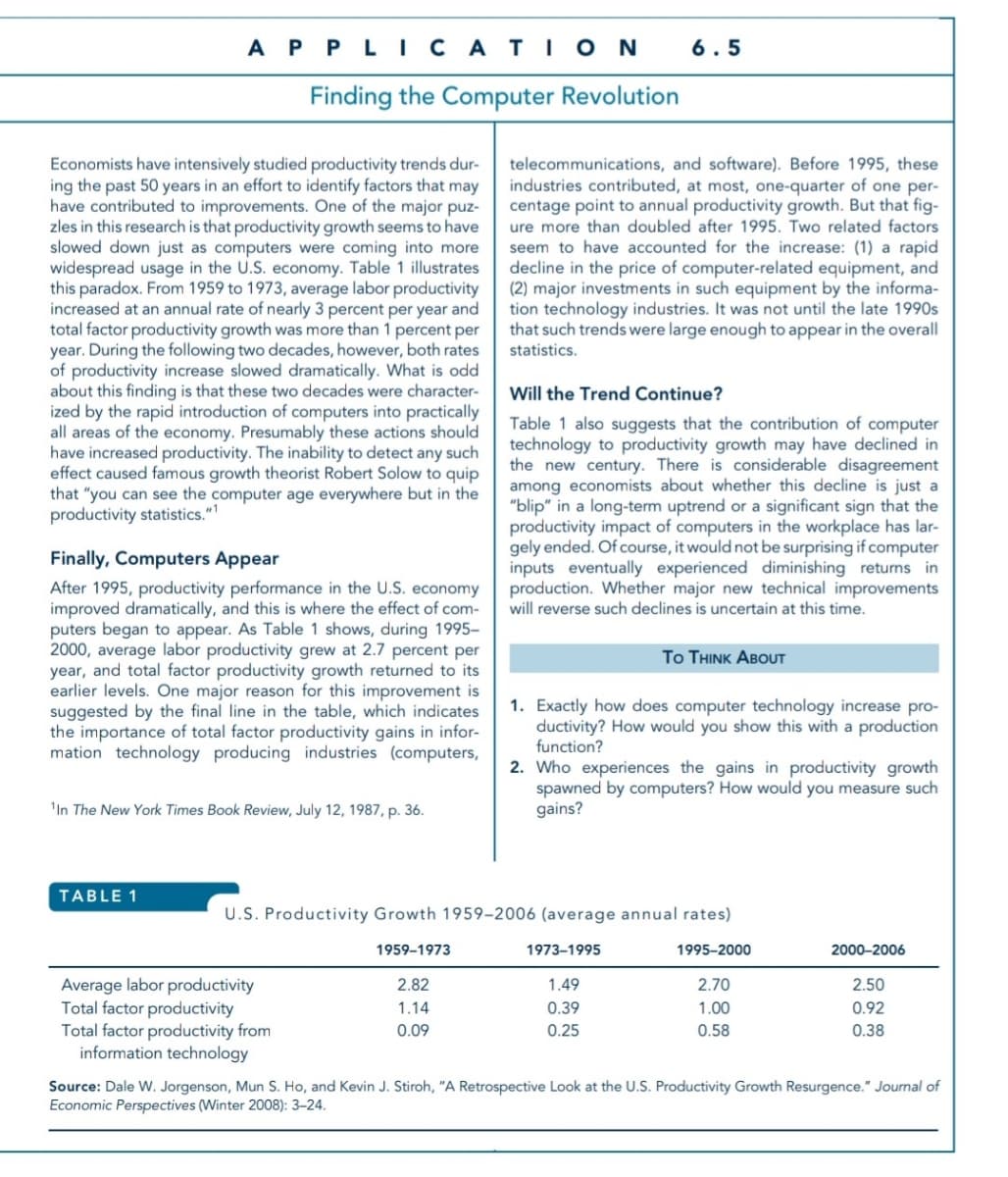Exactly how does computer technology increase productivity? How would you show this with a production function? 2. Who experiences the gains in productivity growth spawned by computers? How would you measure such gains?
Exactly how does computer technology increase productivity? How would you show this with a production function? 2. Who experiences the gains in productivity growth spawned by computers? How would you measure such gains?
Computer Networking: A Top-Down Approach (7th Edition)
7th Edition
ISBN:9780133594140
Author:James Kurose, Keith Ross
Publisher:James Kurose, Keith Ross
Chapter1: Computer Networks And The Internet
Section: Chapter Questions
Problem R1RQ: What is the difference between a host and an end system? List several different types of end...
Related questions
Question
(See the picture below for answer the question)
1. Exactly how does computer technology increase productivity? How would you show this with a production function?
2. Who experiences the gains in productivity growth spawned by computers? How would you measure such gains?

Transcribed Image Text:A P PLI CATIO N
6.5
Finding the Computer Revolution
Economists have intensively studied productivity trends dur-
ing the past 50 years in an effort to identify factors that may
have contributed to improvements. One of the major puz-
zles in this research is that productivity growth seems to have
slowed down just as computers were coming into more
widespread usage in the U.S. economy. Table 1 illustrates
this paradox. From 1959 to 1973, average labor productivity
increased at an annual rate of nearly 3 percent per year and
total factor productivity growth was more than 1 percent per
year. During the following two decades, however, both rates
of productivity increase slowed dramatically. What is odd
about this finding is that these two decades were character-
ized by the rapid introduction of computers into practically
all areas of the economy. Presumably these actions should
have increased product
effect caused famous growth theorist Robert Solow to quip
that "you can see the computer age everywhere but in the
productivity statistics."
telecommunications, and software). Before 1995, these
industries contributed, at most, one-quarter of one per-
centage point to annual productivity growth. But that fig-
ure more than doubled after 1995. Two related factors
seem to have accounted for the increase: (1) a rapid
decline in the price of computer-related equipment, and
(2) major investments in such equipment by the informa-
tion technology industries. It was not until the late 1990s
that such trends were large enough to appear in the overall
statistics.
Will the Trend Continue?
Table 1 also suggests that the contribution of computer
technology to productivity growth may have declined in
the new century. There is considerable disagreement
among economists about whether this decline is just a
"blip" in a long-term uptrend or a significant sign that the
productivity impact of computers in the workplace has lar-
gely ended. Of course, it would not be surprising if computer
inputs eventually experienced diminishing returns in
production. Whether major new technical improvements
will reverse such declines is uncertain at this time.
The inability to detect
such
Finally, Computers Appear
After 1995, productivity performance in the U.S. economy
improved dramatically, and this is where the effect of com-
puters began to appear. As Table 1 shows, during 1995–
2000, average labor productivity grew at 2.7 percent per
year, and total factor productivity growth returned to its
earlier levels. One major reason for this improvement is
suggested by the final line in the table, which indicates
the importance of total factor productivity gains in infor-
mation technology producing industries (computers,
Το THNKAβουT
1. Exactly how does computer technology increase pro-
ductivity? How would you show this with a production
function?
2. Who experiences the gains in productivity growth
spawned by computers? How would you measure such
gains?
'In The New York Times Book Review, July 12, 1987, p. 36.
TABLE 1
U.S. Productivity Growth 1959–2006 (average annual rates)
1959–1973
1973-1995
1995–2000
2000-2006
Average labor productivity
Total factor productivity
Total factor productivity from
information technology
2.82
1.49
2.70
2.50
1.14
0.39
1.00
0.92
0.09
0.25
0.58
0.38
Source: Dale W. Jorgenson, Mun S. Ho, and Kevin J. Stiroh, "A Retrospective Look at the U.S. Productivity Growth Resurgence." Journal of
Economic Perspectives (Winter 2008): 3–24.
Expert Solution
This question has been solved!
Explore an expertly crafted, step-by-step solution for a thorough understanding of key concepts.
This is a popular solution!
Trending now
This is a popular solution!
Step by step
Solved in 2 steps

Recommended textbooks for you

Computer Networking: A Top-Down Approach (7th Edi…
Computer Engineering
ISBN:
9780133594140
Author:
James Kurose, Keith Ross
Publisher:
PEARSON

Computer Organization and Design MIPS Edition, Fi…
Computer Engineering
ISBN:
9780124077263
Author:
David A. Patterson, John L. Hennessy
Publisher:
Elsevier Science

Network+ Guide to Networks (MindTap Course List)
Computer Engineering
ISBN:
9781337569330
Author:
Jill West, Tamara Dean, Jean Andrews
Publisher:
Cengage Learning

Computer Networking: A Top-Down Approach (7th Edi…
Computer Engineering
ISBN:
9780133594140
Author:
James Kurose, Keith Ross
Publisher:
PEARSON

Computer Organization and Design MIPS Edition, Fi…
Computer Engineering
ISBN:
9780124077263
Author:
David A. Patterson, John L. Hennessy
Publisher:
Elsevier Science

Network+ Guide to Networks (MindTap Course List)
Computer Engineering
ISBN:
9781337569330
Author:
Jill West, Tamara Dean, Jean Andrews
Publisher:
Cengage Learning

Concepts of Database Management
Computer Engineering
ISBN:
9781337093422
Author:
Joy L. Starks, Philip J. Pratt, Mary Z. Last
Publisher:
Cengage Learning

Prelude to Programming
Computer Engineering
ISBN:
9780133750423
Author:
VENIT, Stewart
Publisher:
Pearson Education

Sc Business Data Communications and Networking, T…
Computer Engineering
ISBN:
9781119368830
Author:
FITZGERALD
Publisher:
WILEY